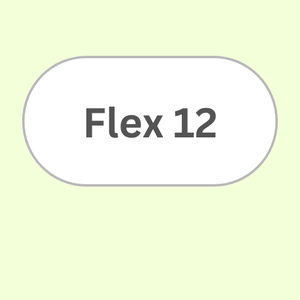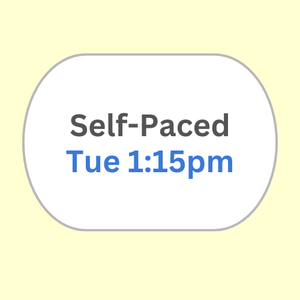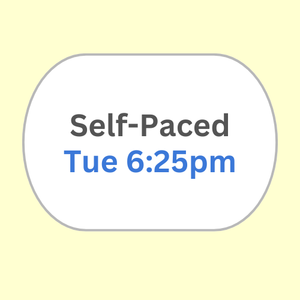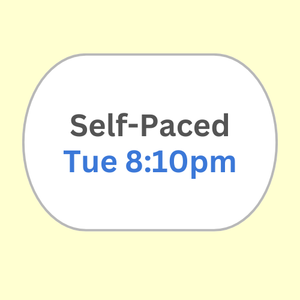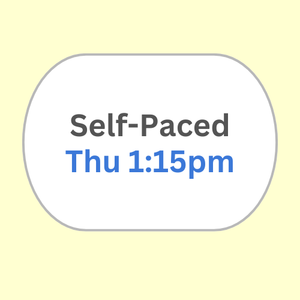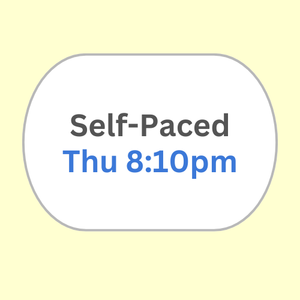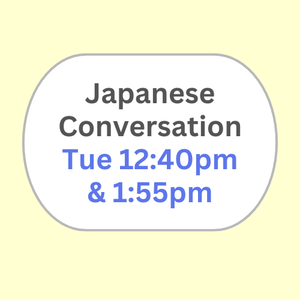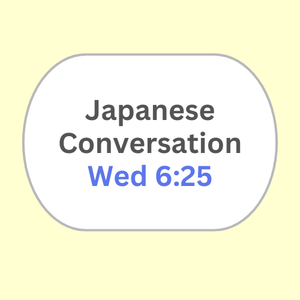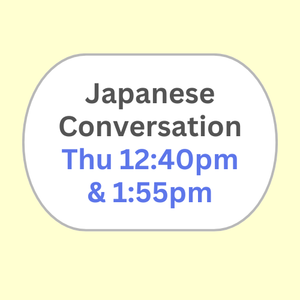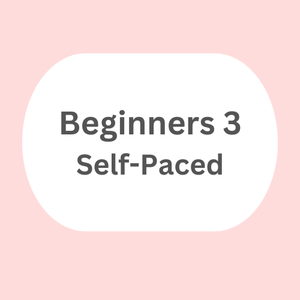Table of Contents
Who We Are
Beyond Language Learning
A Close-Knit Multilingual Community
Join us and become part of a vibrant community where Japanese and English learners teach and learn from each other.
Authentic and Immersive Practice
Experience genuine language practice with native Japanese speakers in our Japanese class providing endless opportunities for real-world application.
Supportive and Community-Centered
Embrace a relaxed, community-oriented approach to learning. Together, we support, grow, and share joyful moments, making every step of the journey enjoyable.
Follow us on Instagram!
Embark on an exciting journey with our Beginners Japanese 3 class, designed to deepen your understanding and enhance your proficiency in Japanese.
Building on previous knowledge, this course will introduce more complex grammar structures and vocabulary, expanding your ability to communicate effectively.
Engage in interactive lessons that include cultural insights, practical dialogues, and varied activities to boost your listening, speaking, reading, and writing skills.
Whether for personal enrichment or professional growth, this class will equip you with the tools to confidently explore the rich language and culture of Japan.
Get ready to take your Japanese skills to the next level!
After Taking This Course
After taking Beginners Japanese 3 class at Blue House Okinawa,
you’ll be able to say Japanese phrases below:
*I’m going to Japan next month.
/ らいげつ、にほんに いきます。
*That’s nice. With whom are you going?
/ いいですね。だれと いきますか。
*I’m going with my friend, Jon. He doesn’t like Japanese food, though. Are there McDonald’s in Japan?
/ ともだちの ジョン と いきます。かれは にほんの たべものが きらいです。にほんに マクドナルドが ありますか。
*Yes, there are many of them. At McDonald’s in Japan, they have Teriyaki Burgers. They have Tsukimi Burgers too.
/ はい、たくさん あります。にほんの マックは、てりやき バーガーが あります。つきみ バーガーも あります。
*Really? Do they have tea? I love tea.
/ そうですか。おちゃは ありますか。ぼくは おちゃが だいすきです。
*No, there isn’t, but they have iced tea.
/ いいえ、おちゃは ありません。でも、アイスティーが あります。
*Okay, then I will go to McDonald’s with Jon.
/ じゃあ、ジョンと マックに いきます。
*Where is a convenience store?
/ コンビニは どこですか。
*There is one next to the gas station.
/ ガソリンスタンドの となりに あります。
*Which gas station is it?
/ どの ガソリンスタンド ですか。
*It’s the one adjacent to the bookstore?
/ ほんやさんの よこの ガソリンスタンド です。
*Oh, I got it now. It’s just about five minutes from here, right?
/ ああ、わかりました。ここから ごふんぐらい ですね。
*Yes, it is.
/ はい、そうですね。
*How about a drug store? (Where is a drug store?)
/ じゃあ、くすりやさんは どこですか。
*There is a good drug store in front of the station.
/ えきのまえに いい くすりやさんが あります。
*Are they inexpensive?
/ やすい ですか。
*Yes, they are. The meat market next to them is inexpensive too.
/ はい、やすです。そのとなりの おにくやさんも やすいです。
*I see. Thank you. I’m going there right now.
/ そうですか。ありがとうございました。これから、いきます。
*I’m going to a party tomorrow.
/ あした パーティーに いきます。
*What time are you going?
/ なんじに いきますか。
*At eight-thirty.
/ 8じはんに いきます。
*Whom are you going with?
/ だれと いきますか。
*I’m going with my friend. Won’t you also come?
/ともだちと いきます。あなたも いきませんか。
*I don’t have any shoes.
/ くつが ありません。
*I will loan you my shoes.
/ わたしの くつを かして あげます。
*Which shoes?
/ どのくつ ですか。
*These blue shoes.
/ この あおいくつ です。
*Thank you.
/ ありがとう。
*The president isn’t here today, is he?
/ きょう、しゃちょうが いませんね。
*Oh, he went to Los Angeles yesterday afternoon.
/ あ、しゃちょうは きのうの ごごに ロサンゼルスに いきました。
*Then there is going to be no conference tomorrow?
/ じゃあ、あしたの かいぎは ありませんか。
*No, there isn’t. I’m not coming to work tomorrow.
/ はい、ありません。わたしは あした、かいしゃに きません。
*What?
/ え!?
*I’m going golfing with Mr. Yamamoto. Then we are going to drink beer at a bar. Won’t you come with us?
/ やまもとさんと ゴルフに いきます。それから、バーで ビールを のみます。いっしょに きませんか。
*I’m going to be busy with my work tomorrow. Besides, I’m going to have dinner with my girlfriend.
/ わたしは あした、しごとが いそがしいです。それに、かのじょと いっしょに ばんごはんを たべます。
*Is that so? It is too bad.
/ そうですか。ざんねん ですね。
*Are you going to be busy this Sunday, Ms. Toyoda?
/ とよだん、こんしゅうの にちようびは いそがしい ですか。
*No, I’m going to be home one Sunday.
/ いいえ、にちようびは うちに います。
*Then, won’t you go to Tokyo Disneyland with me?
/ じゃあ、いっしょに とうきょう ディズニーランドに いきませんか。
*Disneyland? I don’t like amusement parks.
/ ディズニーランド ですか?わたしは ゆうえんちは すきじゃない です。
*Is that so? Then … have you gone to the Van Gogh exhibition? / そうですか。じゃあ、ゴッホてんは もう いきましたか。
*Not yet.
/ まだ です。
*Shall we go then?
/ じゃあ、いっしょに いきませんか。
*It sounds good. Let’s go there.
/ いいですね。いきましょう。
*What time shall we go?
/ なんじに いきましょうか。
*Let’s go there around ten o’clock.
/ じゅうじごろに いきましょう。
What We Will Learn
In Beginners Japanese 3, we’ll study:
Lesson 1 – Lesson 6
*Japanese Pronunciation Basics
*Vocabulary – Words around the House
*Vocabulary – Words around the Kitchen
*Japanese Writing System
*Writing Katakana
*Existence Verbs
*Regular Verb Conjugation
*いる/える Verbs
*The Particle と
*いる To Be, To Exist, To Have: Animate Things
*ある To Be, To Exist, To Have: Inanimate Things
*Vocabulary – Stores and Shops
*Using の for “With Location”
*Using あいだ for Properly
*Using Location to Modify
*Using ひだり and みぎ
*The Difference Between となり and よこ
*Vocabulary – Words around the Office
*Singling Out Items
*The どの Group
*The Difference Between どの and どれ
*Vocabulary – Food Words
*Counting Living Things
*Boys and Girls Indian Song
*Connecting Sentences with そして
*Multiple Ways to Say the Same Thing
*The Difference Between いる、ある and です
*Vocabulary – Other Body Parts
*Verbs that Use を
*The Particle を
*The Particle で
*Particle Review and The Particle Shuffle
*Using 〜ませんか to Invite
*Vocabulary – Words on the Road
*Vocabulary – At the Airport
*The ましょう Verb Stem
*かく to Write
*よむ to Read
*When もうMeans “Already”
*When もうMeans “More”
*When もうMeans “Anymore”
*The ましょう Verb Ending
*Vocabulary – At the Train Station
Self-Paced Method
Personalized Mastery with Self-Paced Learning
The journey to mastering Japanese becomes even more personalized with a self-paced method, combining the best of flexibility with the invaluable support of a dedicated instructor at Blue House Okinawa. This approach adapts to your rhythm, creating a learning experience tailored to your individual needs.
Tailored Learning Pace
A self-paced method at Blue House Okinawa empowers you to control the speed of your learning, allowing you to spend more time on challenging concepts or breeze through familiar topics. You don’t have to wait for other students, enabling you to advance more quickly. This flexibility ensures that your study of Japanese aligns with your personal learning style and daily schedule, making language acquisition a seamless part of your life rather than a disruptive obligation.
Accelerate Your Learning Journey
A significant benefit of the self-paced method is the ability to advance quickly through your studies. You can move forward as soon as you’re ready, making your learning experience more efficient and rewarding. Many students find that they can progress faster with a self-paced approach. By focusing on familiar topics briefly and spending more time on challenging areas, you can tailor your study sessions to your strengths and weaknesses, keeping you motivated and engaged.
Direct Instructor Support When Needed
While the self-paced method offers autonomy, the role of an instructor remains pivotal. Whether you need clarification on complex grammatical structures, pronunciation practice, or insights into cultural nuances, your instructor is there to provide targeted support. This blend of independence and expert guidance ensures you’re never truly alone on your path to fluency.
Deepened Understanding Through Flexibility
The beauty of a self-paced approach lies in the liberty to pause and dive deeply into areas of interest or difficulty. Without the pressure to keep up with a preset class pace, you can ensure that your understanding of the Japanese language is deeply rooted. This flexibility encourages a more reflective and thorough engagement with the language, leading to lasting comprehension and proficiency.
The benefits of a self-paced method supported by an instructor in the context of learning Japanese are manifold. From the flexibility that caters to individual lifestyles to the tailored learning experiences that address specific needs, this approach offers a personalized pathway to language mastery. With the added advantage of deepened understanding and enhanced motivation, learners are well-equipped to embark on a rewarding journey toward fluency in Japanese. Embrace the opportunity to learn at your pace, guided by expertise, and discover the joys of language learning tailored just for you.
Our Textbook
We believe that immersive learning, while difficult, is the most productive and useful way to learn a language; however, many students drop out of immersive programs because it is an overwhelming process initially.
For that reason, we no longer offer immersive courses at beginners’ level.
To accommodate students’ schedules and learning styles, as many of students at Blue House Okinawa work or study full-time, we’ve chosen to use a curriculum that is thorough, slow, and truly begins from ZERO.
Our textbook, Japanese From Zero!, is an innovative and integrated approach to learning Japanese developed by professional Japanese interpreter George Trombley.
It has chapter-by-chapter video supplements on YouTube, making both pre-study and review easily accessible as you move at your desired pace.
It is geared towards English-speaking learners and based on the experience of a native English speaker learning and flourishing in Japanese.
The added support provided through this curriculum and resource has led to increased longevity in pursuing Japanese language skills.
Courses are truly 100% self teachable if our resources are used, and this is particularly helpful for keeping up despite a busy work schedule, vacation, etc.
Blue House Okinawa provides the learning opportunities, guidance, and language exchanges to reinforce, encourage, and grow learners’ abilities.
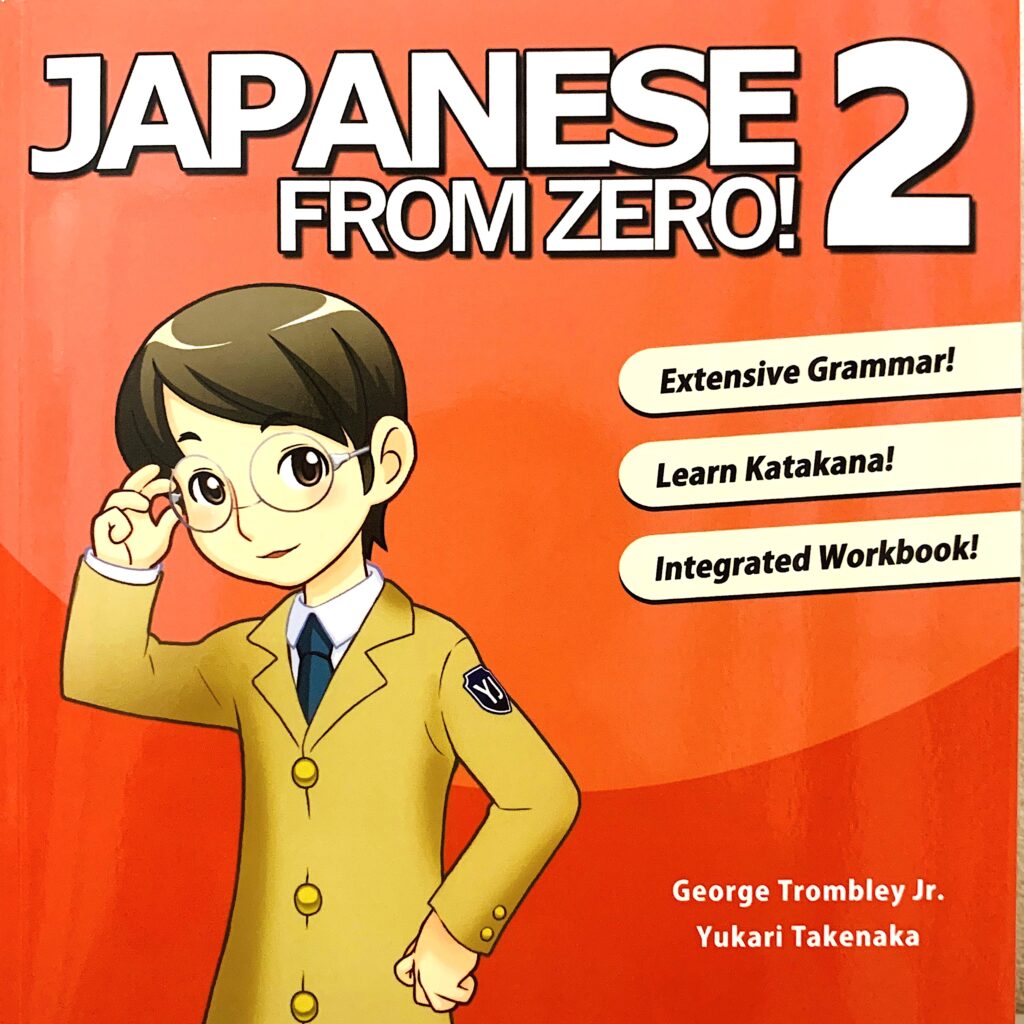
How to Study
1. Watch Lecture Videos on Our Online Resources
Dive into your Japanese learning adventure with lecture videos, your on-demand classroom that fits perfectly into your busy life.
These visual tools allow you to pause, rewind, and rewatch, giving you control over your pace and making tricky concepts stick.
They’re not just about watching; they’re about engaging and preparing you for real-life conversations with native speakers.
With the flexibility to learn anytime and anywhere, these videos transform your journey into an enjoyable, effective path to fluency.
So, why wait?
Press play and let the immersive learning begin!
Example Video:
2. Lesson Activities on the Textbook
Half of your textbook is actually a workbook.
This is because we’re convinced that getting better at writing can really up your game in typing, especially when you’re chatting with your Japanese friends.
So, don’t miss out on using the workbook exercises to give both your writing and typing skills a big boost!
And hey, if you ever find yourself scratching your head over any of the lesson activities, just give your instructor a shout.
We’re all here to help you succeed and have fun along the way!

3. Flashcards on Study Room
You’re zipping through your day, and whether you’re on a coffee break or waiting in line, your phone becomes your gateway to a quick Japanese lesson.
With digital flashcards, you’re actively engaging with the language, thanks to the magic of spaced repetition.
It ensures you review words right when your brain is about to let them slip, making learning stick better.
And if you ever feel like you’re running out of cards, there’s a whole world of pre-made decks online, waiting to be explored.
How to Ace Your Flashcard Review
Flipping Cards: Just tap or click anywhere on a card to see the other side. Simple as that!
Moving Through Cards: Use the left and right arrows on your keyboard or click the arrows at the bottom of the card to move forward or back through your set.
Completing a Round: Make sure to go through every card in the set to wrap up your review session.
Customize Your Study Sets:
Auto-Play: Not in the mood to click through? Hit Play, and the cards will flip through on their own.
Shuffle Mode: Mix it up by selecting Shuffle. This way, you get your cards in a random order for a better challenge.
Language Settings: English popping up first? Wanna start with Japanese instead? Dive into the Options menu and switch it up by choosing Definition under Answer with.
Sounds and Voices: Click the speaker icon on any card to listen to its pronunciation. Handy, right?
Audio Settings: To turn the audio off or on, just open the Options menu. If you want more control over how you hear things, select Show advanced audio options
Our Vocabulary Collections
We’ve noticed that the vocab in textbooks doesn’t always line up with the topics you’re learning about.
That’s why students at Blue House Okinawa have been asking for vocab sets that actually match the topics.
Learning vocab by topic just seems to stick better, so our teachers have been getting creative.
They’ve been putting together extra vocab sets based on what you all have asked for, pulling in words you might not even find in your textbooks.
A lot of the vocab stuff we have comes directly from student suggestions over the years.
This has allowed us to put together collections that really get you ready to dive into real conversations about your interests in the language you’re learning, right from the start.
Our instructors at school are all about giving you a vocab that’s right for your learning level and creating these easy-to-use resources for you.
But, if you prefer sticking to the textbook order for vocab, that’s totally fine. And remember, making your own flashcards is always a great option too. 🙂
it = “sore ha”
The digital flashcards are awesome for studying, and we absolutely love them!
But, we did run into a little problem.
Our textbooks sometimes skip over topics because, in Japanese, it’s common to drop the topic from a sentence if everyone already knows what you’re talking about.
This threw a bit of a curveball for our students using flashcards.
Since you need your answers and the flashcard answers to match exactly, it was tricky figuring out when to drop the topic and when to keep it in.
To keep things simple, we’ve decided to always use “それは” (sore ha) to mean “it” in sentences, even though that might not always match your textbook.
Just a heads-up: make sure to type “それは” every time you come across “it” in the sentences.
And hey, if you prefer sticking to how the textbook does things, no worries!
You’re more than welcome to make your own flashcards and worksheets.
They can be super handy during Language Exchange. 😊
4. Flashcards “Learn” on Study Room
To use these flashcards, Select or type the correct answer.
Settings and options
To customize your session, open the Options menu.
You can choose to answer with terms, definitions, or a specific language (if applicable).
You can also choose to study only starred terms, change your audio settings, and select which question types are included.
5. Flashcards “Spell” on Study Room
Spell mode helps you practice spelling terms by prompting you to type what you hear.
To finish a round of Spell mode and see your results, you’ll need to spell each word correctly twice.
Settings and options
If you misspelled a word, the letters you missed will be highlighted and the word will be spelled out for you. Then, you can try it again.
You can slow down the audio by selecting Options and choosing Slow.
To hear a term again, click the Speaker.
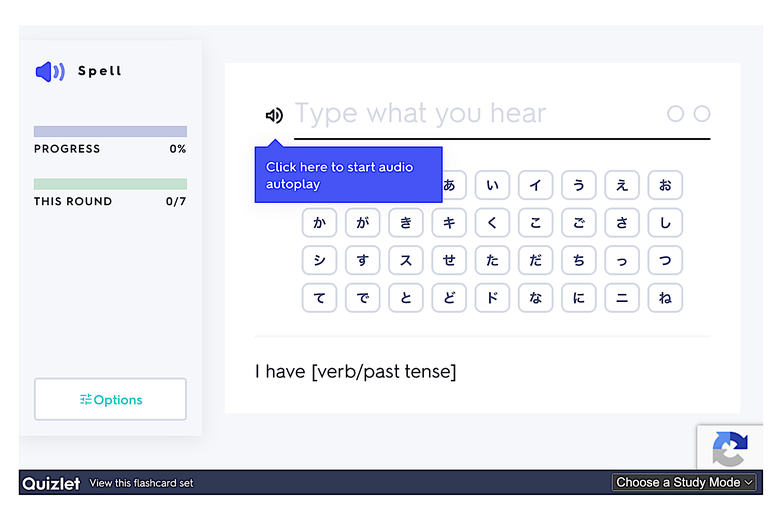
6. Lesson Quizzes on Our Online Resources
Get ready for a little victory at the end of each lesson, because that’s quiz time!
Aim for the stars and try to score 80% or higher on these quizzes.
The best part?
You can retake them as many times as you need to hit that sweet 80% mark or even go beyond.
Remember, repetition isn’t just a step in learning a new language—it’s the secret sauce!
So embrace those quizzes, and let’s see your scores soar!
7. Q&A Making on the Workbook
After you’ve hit 80% or more on lesson quizzes, why not take a creative leap and come up with your own questions?
Feel free to jot them down in either Japanese Hiragana or Romaji right on the back of the lesson’s worksheets.
These questions are perfect for sparking conversations with local Japanese friends during Language Exchanges or Study Exchanges.
And guess what?
Often, your Japanese friends will flip the script and ask, “How about you?” So, make sure you’re also prepped with your own answers in Japanese!
It’s a fun way to deepen your understanding and make those language connections even stronger.
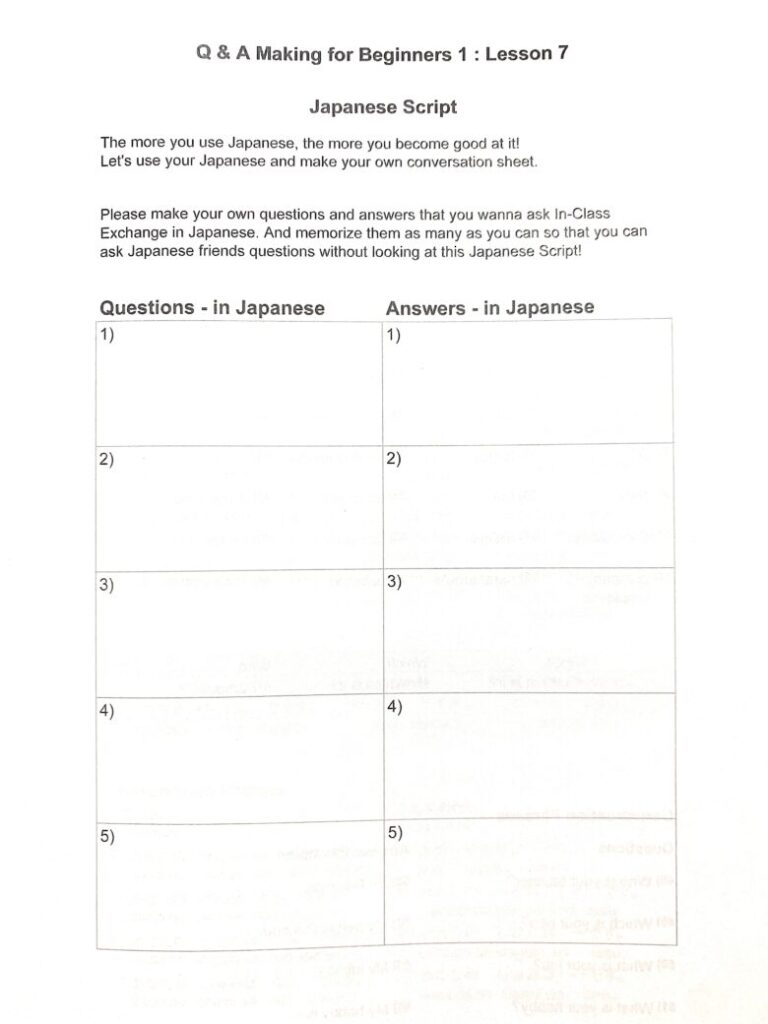
8. 1 Post & 5 Comments on Our School Social Media
You asked for more ways to practice Japanese, and guess what?
We’ve got you covered with our school social media, made for you amazing students! 🌟
Now you can flex your language muscles anytime, anywhere—whether you’re chilling at home, on your daily commute, or just scrolling through your phone with some time to spare.
Dive into our school social media and you’ll find all sorts of fun ways to keep up with your Japanese studies.
Post, comment, slide into DMs, and do everything you need to boost your language skills.
Plus, you get to support our awesome local Japanese friends who are learning English, just like in our Language Exchange program at school.
Feeling a bit shy about your Japanese?
Pop into the Living Room to ask if your Japanese hits the mark, or lend a hand (and your English skills) to help local students master English with your comments and posts.
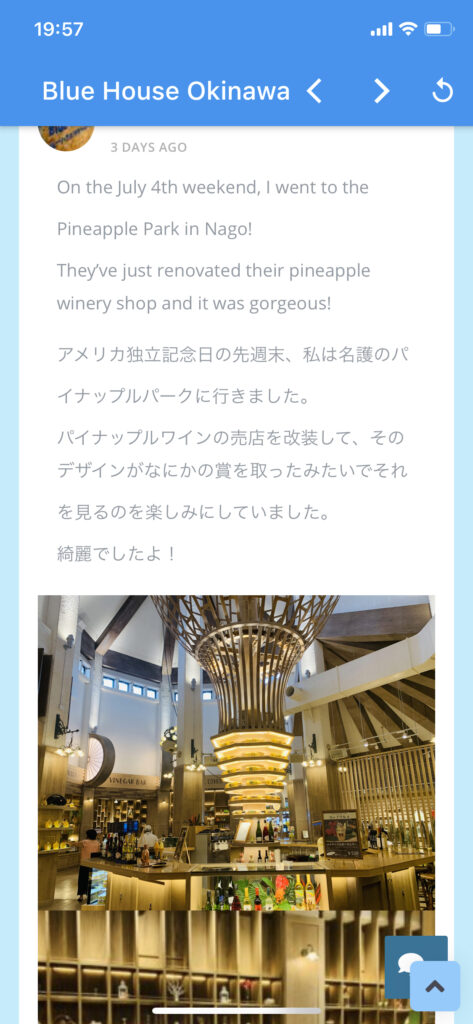
9. Host a Study Exchange
Want to try out your Japanese?
Or, do you like to practice your listening and speaking?
Then, host a Study Exchange and study with local Japanese friends!
At the Study Exchange, you can:
*see if you remember what you’ve learned.
*see if your Japanese friends understand your Japanese.
*listen to native Japanese speakers’ Japanese pronunciation.
*learn how native Japanese speakers use Japanese.
*understand what your Japanese friends think, how they look at things, and how they express their feelings.
*understand Japanese culture on a deeper level.
Sounds so exciting, right?
Oh after the Study Exchange, don’t forget to post the report for your review!
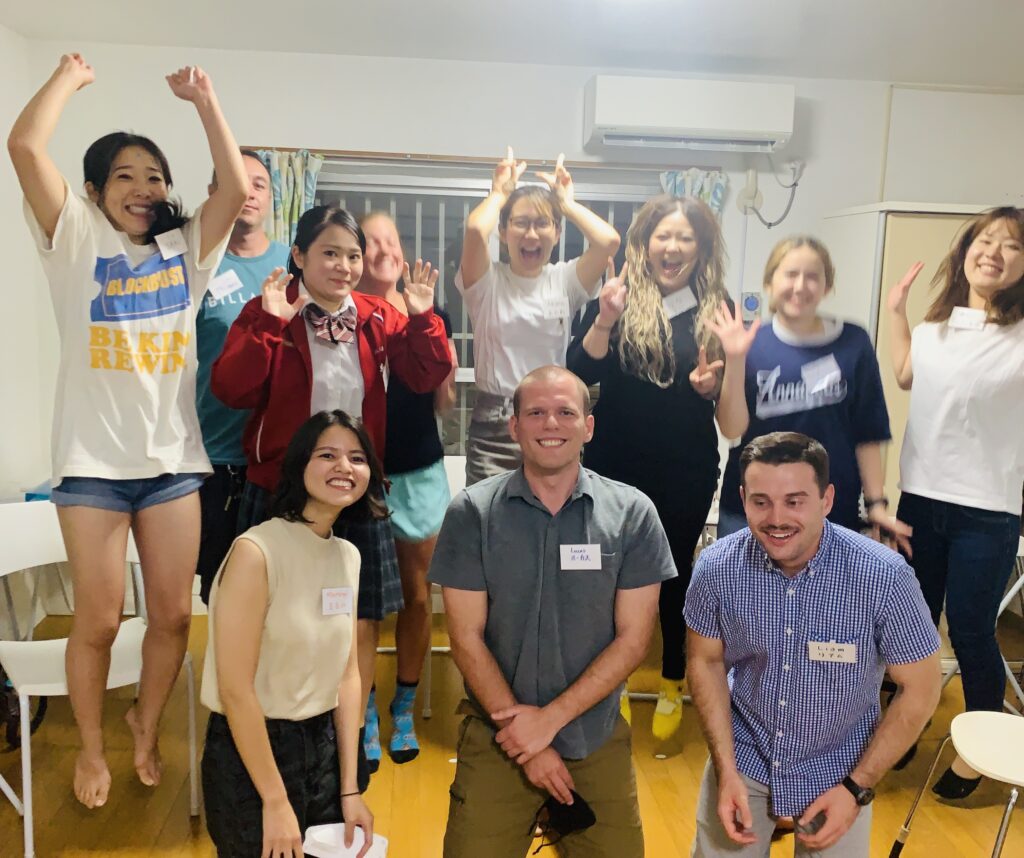
Practice in Class
1. Ask Questions if There Are Any
Asking questions in class is your secret weapon for learning!
It clears up confusion, deepens your understanding, and even helps your classmates who might be wondering the same thing.
Plus, it shows you’re engaged and eager to learn.
So don’t hesitate—every question is a step toward mastering the material!
2. Take the Performance Test with the Instructor
Taking the Japanese speaking performance test with your instructor is a golden opportunity in your language learning journey.
It’s not just a test; it’s a chance to get personalized feedback on your pronunciation, grammar, and conversational skills.
This experience boosts your confidence and hones your ability to speak Japanese fluently. Embrace this moment—it’s designed to highlight your strengths and guide your progress toward becoming a confident and proficient speaker.

3. Listening and Speaking Practice with Native Japanese Speakers in Language Exchange
It immerses you in the language’s natural rhythm, intonation, and cultural nuances, making learning authentic and engaging.
This direct interaction boosts your listening comprehension and speaking fluency, allowing you to pick up colloquial expressions and slang.
Moreover, it builds confidence in real-world communication and fosters a deeper understanding of Japanese culture.
These exchanges are a crucial part of mastering the language in a way textbooks alone cannot provide.
4. Ask Native Japanese Speakers the Questions You Made
This immersive experience helps learners grasp nuanced pronunciations, understand colloquial expressions, and become familiar with cultural contexts, improving listening and speaking skills.
It encourages active learning through real-time feedback, helping to correct mistakes and clarify doubts immediately.
Engaging with natives also boosts confidence in using the language in everyday scenarios, making the learning process more enjoyable and effective.
Overall, it’s a direct, practical approach to mastering Japanese, making it easier to think and communicate fluently in the language.
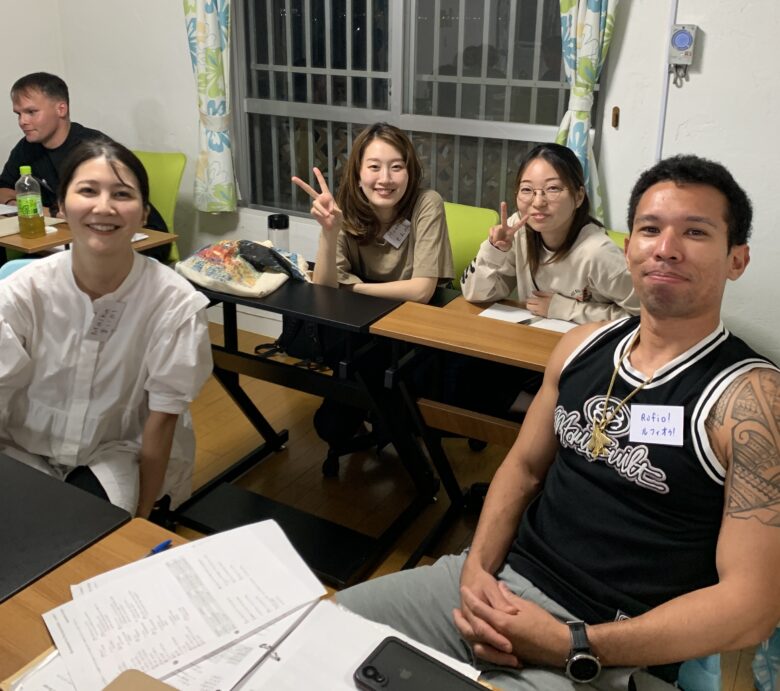
Our Payment Methods
At Blue House Okinawa, we provide two tailored payment options to suit various needs and learning styles across different class settings. Whether you prefer an intensive learning environment or require flexibility to accommodate a busy schedule, we have the ideal class for you. Below, we outline the key differences between our Flexible Class and Regular Class.
Flex Class (Flexible Schedule)
In the Flex Class, you can purchase as many coupons as you’d like, then book and attend lessons at your convenience.
You can:
- Purchase the desired number of coupons each month and use them to book ANY LESSONS YOU LIKE.
- Coupons are valid only for the current 4-week subscription period and cannot be carried over to the next 4-week subscription period.
- Book lessons online, anytime and from anywhere.
- Easily reschedule your lessons if needed.
- Start learning now!
Regular Class
In the Regular Class, your class, schedule, and tuition are fixed. This helps you build a consistent Japanese study habit.
You can:
- Develop a steady and consistent study routine.
- Attend 8 lessons per month at a lower cost compared to the Flex 8 plan.
- Follow a fixed class schedule, attending the same class at the same time each week.
- Pay a fixed tuition fee, it covers one month/term regardless of your attendance.
- Rescheduling or make-up lessons for missed classes are NOT AVAILABLE.
- Begin the class at the start of each month.
For more details, please see the information below.
Flexible Schedule Class
Discover the Ultimate Flexible Schedule Class
In today’s fast-paced world, balancing work, studies, and family commitments can be challenging. Our Flexible Schedule Class is designed for busy individuals, those traveling from afar, and anyone who prefers online learning. This hybrid class offers the best of both worlds, allowing you to tailor your education to fit your lifestyle seamlessly. You can purchase coupons and book your lessons at your convenience, making it perfect for those with busy schedules.
Why Choose Our Flexible Schedule Class?
1. Pay Only for the Lessons You Attend
Like to attend Japanese classes but can’t commit to a weekly schedule? Then our Flex Class system is perfect for you. Simply purchase coupons and book lessons as they fit your schedule. You only pay for the lessons you actually attend, ensuring there’s no wasted money!
2. Create Your Own Lesson Schedule
With the Flex Class system, you have complete control over your schedule. Whether you want to focus intensively on studying Japanese by attending multiple classes each week or prefer a lighter schedule, you can customize your learning to match your availability. This flexibility allows you to balance personal and professional commitments while continuing your studies.
3. Buy as Many Coupons as You Need
You can purchase as many coupons as you like, depending on your goals and availability. If you’d like to dedicate more time to your Japanese studies, buy more coupons. If you have a busy month, you can buy fewer. It’s entirely up to you!
4. Easy to Continue
The flexibility of our Flex Class system makes it easier to continue your learning journey without interruptions. As your schedule changes, you can adjust your lessons accordingly, ensuring consistent progress. This adaptability is ideal for those with unpredictable commitments.
5. Coupons Can Be Used for Any Class
Your Flex Class coupons can be used for any class, whether it’s a self-paced beginners Japanese class or a Japanese conversation class. For example, with 8 lessons, you can attend 4 beginner classes and 4 conversation classes—or mix and match however you like!
6. Book Lessons Anytime, Anywhere
With our easy online booking system, you can book your lessons from anywhere at any time. You can book lessons as early as 1 hour before or up to 4 weeks in advance, making it convenient for even the busiest of schedules.
7. Easily Reschedule Lessons
If you need to cancel a lesson, you can do so up to 24 hours in advance, and your coupon will be available for another booking. This flexibility ensures that even with an irregular schedule, you can continue learning without stress.
8. Start now!
No need to wait for the start of a new term. With our Flex Class, you can begin your lessons and start using our online program and resources as soon as you sign up. Whether you’re eager to start immediately or prefer to plan ahead, our system lets you jump into learning right away.
9. Switch to Regular Classes Anytime
If your schedule changes and you have more time to dedicate to your studies, switching from our Flex Class to our Regular Classes is easy and can be done online. You can also adjust your class level or add another class after completing your current one. Our system is designed to grow with you!
Flexible Schedule Class Tuition
Registration Fee 11,000 yen
Class Materials
Japanese Conversation: 7,200 yen
Beginners Japanese 1 & 2: 7,700 yen
Beginners Japanese 3 & 4: 7,700 yen
Pre-Intermediate Japanese 1: 6,600 yen
Pre-Intermediate Japanese 2: 6,600 yen
Pre-Intermediate Japanese 3: 6,600 yen
JLPT Prep N5: 6,600 yen
JLPT Prep N4: 8,800 yen
JLPT Prep N3: 11,000 yen
*The registration fee and the class materials are required for a new student and each student.
Tuition Subscription Renewal Date
The subscription renewals monthly on the date you signed up. You can cancel the subscription at any time as needed.
Lesson Booking Policy
-You can book a lesson from 1 hour to 5 weeks before the lesson in advance.
-Your coupon will be available for use from the day your subscription renews for up to 4 weeks.
-Please note that the coupon cannot be carried over to the next 4-week subscription period.
-Coupons are displayed on the payment page and can be used by selecting them.
Lesson Cancellation Policy
-Cancellations made more than 24 hours before the scheduled lesson:
Your coupon will be reactivated and can be used to book another lesson.
Cancellations made within 24 hours before the scheduled lesson:
Your coupon will be forfeited and cannot be used for future bookings.
Please send your instructor a message on Living Room and let him/her know when you cancel a lesson within 24 hours before the scheduled lesson.
Class Cancellation Policy
-You may cancel your class, provided the coupon hasn’t been used.
-Cancellations made within 5 days of payment: 90% refund.
-Cancellations made more than 5 days after payment: No refund.
Upon cancellation of your subscription, access to lesson booking coupons, and online materials will be discontinued.
Flexible Schedule Class Tuition
– Self-Paced Class is for Beginners Japanese 1 – 4, Pre-Intermediate Japanese 1 – 3 and JPLT Prep.
– You can purchase coupons as many as you like and book your lessons at your convenience. Choose from the following options.
- Flex 1 ¥ 6,100
6,100 Yen/Lesson - 1 lesson a month.
- Flex 2 ¥ 11,000
5,500 Yen/Lesson - 2 lessons a month.
- Flex 3 ¥ 14,800
4,933 Yen/Lesson - 3 lessons a month.
- Flex 4 ¥ 18,500
4,625 Yen/Lesson - 4 lessons a month.
- Flex 6 ¥ 26,400
4,400 Yen/Lesson - 6 lessons a month.
- Flex 8 ¥ 33,400
4,175 Yen/Lesson - 8 lessons a month.
- Flex 10 ¥ 39,600
3,960 Yen/Lesson - 10 lessons a month.
- Flex 12 ¥ 46,200
3,850Yen/Lesson - 12 lessons a month.
- Flex 16 ¥ 59,800
3,738 Yen/Lesson - 16 lessons a month.
Register today to save your spot!
*Display price is a price for per lesson.
How to Book a Lesson
Once you sign up for the Flex class, you can start booking your lessons as below.
Your coupon will be applied on the checkout page.
Lesson Booking Policy
– You can book a lesson from 1 hour to 5 weeks before the lesson in advance.
– Your coupon will be available for use from the day your subscription renews for up to 4 weeks.
– Please note that the coupon cannot be carried over to the next 4-week subscription period.
– Coupons are displayed on the payment page and can be used by selecting them.
Check lesson availabilities below.
How to Cancel the Lesson
After booking a lesson, you can cancel it here if needed here.
*You need to be a student to access your account page.
*Lesson Booking Cancellation Policy
– Cancellations made more than 24 hours before the scheduled lesson:
Your coupon will be reactivated and can be used to book another lesson.
– Cancellations made within 24 hours before the scheduled lesson:
Your coupon will be forfeited and cannot be used for future bookings.
– Please send your instructor a message on Living Room and let him/her know when you cancel a lesson within 24 hours before the scheduled lesson.
Regular Class
At Blue House Okinawa, we provide two tailored payment options to suit various needs and learning styles across different class settings. Whether you prefer an intensive learning environment or require flexibility to accommodate a busy schedule, we have the ideal class for you. Below, we outline the key differences between our Regular Class and Flexible Schedule Class.
Intensive Learning with a Fixed Schedule
Our Regular Class is perfect for those committed to mastering Japanese. Attend classes weekly on the same days and times, ensuring a consistent and reliable routine. Benefit from regular, focused practice, immediate feedback from experienced instructors, and interaction with dedicated peers. This structured approach helps you stay disciplined, making steady progress towards fluency.
Why Choose Our Regular Class?
1. Easy to Build Study Habits
With a fixed schedule, it’s easier to build and maintain your study habits. Attending classes on the same days and at the same times each week helps integrate learning into your routine, making it a regular part of your life.
2. Accelerate Your Progress
Join our Regular class and attend lessons weekly to fast-track your language learning journey. Regular attendance not only enhances your understanding of the Japanese language but also speeds up your progress, helping you achieve your goals faster and more effectively.
3. Improve Listening and Speaking Skills Faster
Frequent classes enhance your Japanese listening and speaking skills more quickly too. Engaging in regular conversations with native Japanese speakers and receiving direct feedback from instructors improve your practical communication abilities.
4. Cost-Effective
The Self-Paced Regular Class is more cost-effective compared to taking eight/four Flexible Schedule lessons. This makes it an economical choice for those looking to maximize their learning within a budget.
5. Switch to Flex Class Anytime!
When you sign up for a Regular Class, you have the freedom to switch to a Flex Class anytime in the future. Changing your class is easy and can be done online with just a few clicks. Enjoy the flexibility to choose the learning style that best suits your needs!
Regular Class Tuition
Registration Fee 11,000 yen
Class Materials
Japanese Conversation: 7,200 yen
Beginners Japanese 1 & 2: 7,700 yen
Beginners Japanese 3 & 4: 7,700 yen
Pre-Intermediate Japanese 1: 6,600 yen
Pre-Intermediate Japanese 2: 6,600 yen
Pre-Intermediate Japanese 3: 6,600 yen
JLPT Prep N5: 6,600 yen
JLPT Prep N4: 8,800 yen
JLPT Prep N3: 11,000 yen
*The registration fee and the class materials are required for a new student and each student.
Regular Class
–Follow a fixed class schedule, attending the same class at the same time each week.
-Pay a fixed tuition fee, it covers one month/term regardless of your attendance.
-Rescheduling or make-up lessons for missed classes are NOT available.
-Begin the class at the start of each month.
Tuition
– Early Bird Discount
The payment for the upcoming term or month by the 20th of the preceding month are eligible for a 20% early bird discount.
– 2 Payment Methods
There are two payment methods available.
By Term: Covering a 2-month period.
By Month: Covering a 1-month period.
– Tuition Subscription Renewal Date
The subscription renews on the 20th of the preceding month. You can cancel the subscription at any time as needed.
Class Cancellation Policy
-90% refund for cancellation greater than 7 days prior to the 1st day of class
-50% refund for cancellation 1-7 days prior to 1st day of class
-NO refunds for cancellation after the 1st day of class
Register at least 1 day prior to the 1st day of class. If a class is already in session, please wait until the next term starts to register.
2025 School Calendar
Winter
Winter Break : 20 Dec ‘24 – 6 Jan ‘25
January : 7 Jan – 30 Jan
February : 4 Feb – 27 Feb
March : 4 Mar – 27 Mar
Spring
Spring Break : 28 Mar – 7 Apr
April : 8 Apr – 1 May
May : 6 May – 29 May
June : 3 Jun – 26 Jun
Summer
Summer Break : 27 Jun – 7 Jul
July : 8 July – 31 July
August : 5 Aug – 28 Aug
September : 2 Sep – 25 Sep
Fall
Fall Break : 26 Sep – 6 Oct
October : 7 Oct – 30 Oct
November : 4 Nov – 27 Nov
December : 2 Dec – 25 Dec
Winter Break : 26 Dec ‘25 – 5 Jan ‘26
Self-Paced Regular Class Tuition
– Self-Paced Class is for Beginners Japanese 1 – 4, Pre-Intermediate Japanese 1 – 3 and JPLT Prep.
– This class meets twice a week.
- By Term with Early Bird Discount ¥ 55,400
The payment for the upcoming term by the 20th of the preceding month.
- By Term with Regular Price ¥ 66,500
The payment for the upcoming term after the 20th of the preceding month.
- By Month with Early Bird Discount ¥ 27,700
The payment for the upcoming month by the 20th of the preceding month.
- By Month with Regular Price ¥ 33,900
The payment for the upcoming month after the 20th of the preceding month.
Japanese Conversation Class Tuition
– This class meet once a week.
– Tuition Subscription Renewal Date
The subscription renews on the 20th of the preceding month. You can cancel the subscription at any time as needed.
- By Term with Early Bird Discount ¥ 27,700
The payment for the upcoming term by the 20th of the preceding month.
- By Term with Regular Price ¥ 33,900
The payment for the upcoming term after the 20th of the preceding month.
- By Month with Early Bird Discount ¥ 15,400
The payment for the upcoming month by the 20th of the preceding month.
- By Month with Regular Price ¥ 18,500
The payment for the upcoming month after the 20th of the preceding month.
Register today to save your spot!
- Sale!

Beginners Japanese 3
¥27,700 – ¥66,500Select options This product has multiple variants. The options may be chosen on the product page
Both the Regular Class and the Flexible Schedule Class offer unique benefits tailored to different needs. The Regular Class provides a structured environment that helps build consistent study habits, ensures faster progress, and improves practical language skills. On the other hand, the Flexible Schedule Class offers convenience and flexibility, allowing you to learn at your own pace, pay only for the lessons you take, and start immediately.
No matter which class you choose, you will receive high-quality instruction and support from our experienced teachers. Our goal is to provide you with the tools and resources you need to succeed in learning Japanese, whether you prefer a regular schedule or require the flexibility to fit learning into a busy life.
Join Us Today!
Don’t let a busy schedule or distance stop you from learning Japanese. Choose the class that best fits your needs and start your journey with us. Our flexible and regular classes are designed to accommodate your lifestyle and help you achieve your language learning goals.
How to Start
Here are the easy steps to get you started with your Beginners Japanese 3 class.
1. Please take a moment to review our cancellation policy on the registration page.
2. Go ahead and sign up for the class.
3. Complete the online orientation. Don’t worry, we’ll send you the link automatically once you’ve registered.
4. Familiarize yourself with our student agreement and house rules.
5. Register and set up your profile on our school social media.
6. Install and set up the Japanese keyboard on your devices.
7. Introduce yourself on our school social media to connect with your classmates.
8. Once you’ve completed all the steps, drop us a message on Living Room.
We’re excited to have you join us and can’t wait to see you in class!
As we wrap up our Beginners Japanese 3 class, you now possess a stronger foundation in Japanese, equipped with more advanced grammar and an enriched vocabulary.
Through engaging activities and cultural exploration, your ability to communicate in Japanese has been significantly enhanced.
We encourage you to continue practicing and immersing yourself in the language and culture to maintain and build on your progress. Remember, language learning is a continuous journey—keep exploring, practicing, and enjoying the process. Best of luck as you continue your adventure in Japanese!
Who We Are
Beyond Language Learning
A Close-Knit Multilingual Community
Join us and become part of a vibrant community where Japanese and English learners teach and learn from each other.
Authentic and Immersive Practice
Experience genuine language practice with native Japanese speakers in our Japanese class providing endless opportunities for real-world application.
Supportive and Community-Centered
Embrace a relaxed, community-oriented approach to learning. Together, we support, grow, and share joyful moments, making every step of the journey enjoyable.
Follow us on Instagram!







